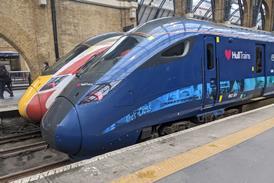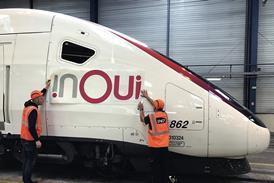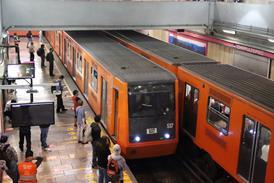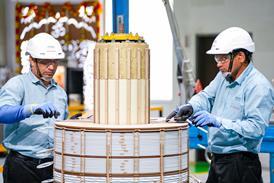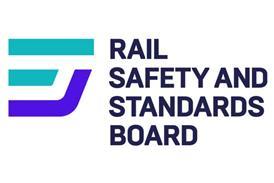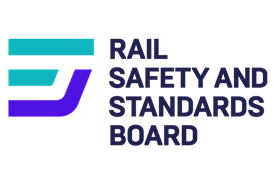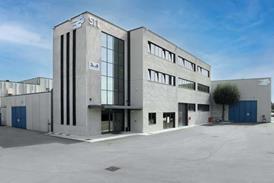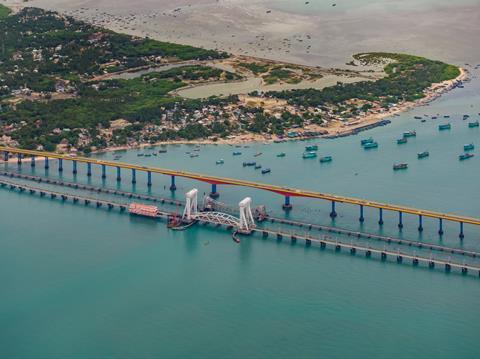
INDIA: A new Pamban railway bridge in Tamil Nadu’s Ramanathapuram district was formally inaugurated on April 6, when Prime Minister Narendra Modi operated the vertical lift span to facilitate the passage of a naval coastguard vessel.
Crossing the shallow Palk Strait which separates southern India and Sri Lanka, the bridge carries the line from Mandapam on the mainland to Rameswaram on Pamban Island. India’s first vertical lift bridge is the centrepiece of a 2 km viaduct across the Pamban channel. It replaces a double-leaf Scherzer cantilever rolling lift bridge dating from 1914 which was originally built to metre gauge and converted to 1 676 mm gauge in 2007.
The old bridge was extensively rebuilt following a cyclone in 1964 and strengthened in 2009, but it was then hit by a barge in 2013. Following the discovery of severe corrosion in 2018, the structure was deemed life-expired. IR’s Southern Railway services were temporarily cut back to Mandapam and a replacement bus service operated using the parallel road bridge completed in 1988.
A replacement railway bridge was authorised in 2019, and the Prime Minister laid the foundation stone in November of that year. Construction began in February 2020 under the aegis of Indian Railways’ project subsidiary Rail Vikas Nigam Ltd, but the work was severely impacted by the Covid-19 pandemic.
Fixed and moving spans
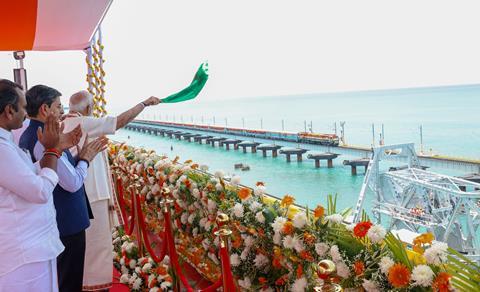
Built alongside the old structure, the 2 060 m long sea bridge has been built with double track and can accommodate 25 tonne axleloads. The line has been electrified at 25 kV 50 Hz, using rigid overhead on the lifting span itself. The final cost is estimated to be more than Rs5·35bn.
The new bridge has 100 spans of 18·3 m each, which are 3 m higher above sea level than the old bridge. The 72·5 m lifting span provides a clear width of 63 m over the navigational channel and a vertical clearance of 17 m. Sensors provide for railway operations to be suspended when wind speeds exceed 58 km/h.
According to RNVL, much of the bridge has been built using E-350 grade stainless steel, which has a zinc coating and a specialised polysiloxane paint finish to withstand the corrosive sea atmosphere. The track is laid with 60 kg rails, using 20 m lengths to reduce the number of rail joints to be maintained. An expansion joint provides for up to 440 mm of adjustment as the structure expands and contracts. The new bridge has been designed to accommodate axleloads up to 25 tonnes.
The vertical lift span was designed by Spanish firm Typsa, and manufactured at Sattirakkudi, 20 km from the coast. It was brought to site in parts and assembled close to the final location, before being moved the final 450 m into position. The 660 m tonne span is supported by counterweights in the four corner towers, and raised using an electromagnetic drive. This takes 5½ min to open, compared to 30 min for the manually operated lifting bridge.
Improved connectivity

According to SR, the opening of the new bridge will reduce the journey time between mainland India and Rameswaram Island from 25 or 30 min to around 15 min, as trains crossing the old structure were restricted to a maximum speed of 40 km/h.
The bridge was designed for 80 km/h, but has only been authorised for 75 km/h, with the Commissioner for Railway Safety expressing concerns about the curvature of the structure and the novel construction techniques. The lifting span itself has a speed limit of 50 km/h.
As well as the ferry connections to and from Sri Lanka, Rameswaram is a major pilgrimage destination. During the inauguration, Modi commented that the new bridge would ‘support ease of doing business and ease of travel, and have a positive impact on the lives of lakhs of people’. He added that the occasion was ‘special day for India’s efforts to build top-quality infrastructure’.

